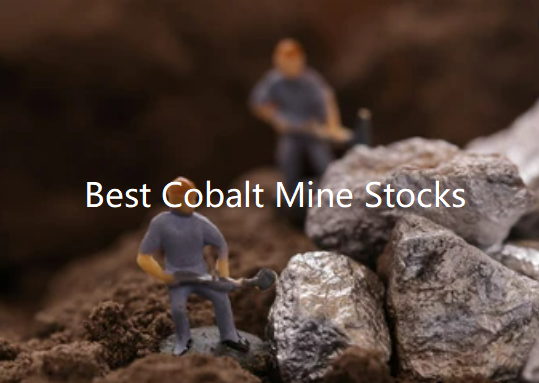
Jimmy Khan
Aug 11, 2022 16:56

It might be difficult to invest in the production of commodities like cobalt, and supply and demand shift from month to month and year to year, causing prices to alter drastically. The price of the stocks of the firms that produce these commodities might also change drastically. If you're an investor looking for more consistent returns or investment income, concentrate on investing in well-established companies with a track record of producing solid profit margins.
However, cobalt is potential raw material. The next ten years may be very profitable for manufacturers of the element if battery technology keeps improving and there is a rise in the demand for renewable energy projects, electric automobiles, and other electric vehicles.
The lithium-ion batteries that electric power vehicles (EVs) and cell phone batteries now can't function without cobalt. Due to government assistance for the sale and manufacture of EVs, the price of this precious metal rose by 118% last year. However, the scarcity of lithium-ion batteries has been the manufacture of EVs' bottleneck. EV adoption is anticipated to compound yearly by 29% through 2030, showing a favorable prognosis for cobalt stockpiles. This might be a difficulty for the EV sector.
According to experts, the demand for the metal is predicted to increase by 9% yearly between 2020 and 2026, and will exceed its supply by 2025. A total of 170,000 metric tonnes of cobalt were produced in 2021, according to the US Geological Survey (UGS). Cobalt is a rare metal that is mostly a byproduct of the mining of nickel and copper, in contrast to more prevalent metals like copper, manganese, and nickel.
Despite not being the world's top producer, China has most cobalt processing facilities. Due to its application in semiconductor chips in consumer electronics like mobile phone batteries, cobalt is in great demand in China. China is the world's largest manufacturer of mobile phones and electric vehicles. Normally, 9 kilos of cobalt are needed for an EV battery. On the other hand, mobile phone batteries need 30 grams of cobalt.
Finding a company solely committed to cobalt production makes investing in cobalt stocks a difficult prospect. Furthermore, the Democratic Republic of the Congo (DRC), a nation plagued by problems with human rights abuses brought on by internal wars, a developing economy, and risky mining operations, produces close to 71% of the world's cobalt. Investors looking to invest in cobalt via stocks increase geopolitical, environmental, social, and governance (ESG) risks. Investors seem to be positive about several well-known cobalt equities, including Carpenter Technology Corporation (NYSE: CRS), Umicore SA (OTC: UMICY), and Sherritt International Corp. (SG: HRT.SG).

The production of cobalt has recently become a lucrative venture. Cobalt prices, however, may be quite erratic, much like the pricing of other commodities. Furthermore, there aren't any pure-play cobalt stocks in the metal mining sector since cobalt is a byproduct. Several cobalt stocks are not traded on the US market.
The iShares MSCI Global Metals & Mining Producers ETF (NYSEMKT: PICK) or the Amplify Lithium & Battery Technology ETF are two excellent choices for purchasing shares of an international mining exchange-traded fund (ETF) that invests more particularly in companies engaged in battery technology (NYSEMKT: BATT).
One of the largest mining companies in the world, BHP Group was founded in Australia and has operations all over the globe. The company extracts metals, energy, and raw materials. Cobalt is naturally mined by BHP since it is a byproduct of the production of nickel and copper, two of its main products.
In 2021, BHP and AI computing startup KoBold Metals, which uses algorithms to choose where to explore and buy property, signed a collaborative deal. The agreement is designed to make it simpler for BHP to get the metals, like as cobalt and nickel, required to produce the batteries for electric cars and other renewable energy projects.
Despite the cyclical growth seen by the mining industry, BHP Group consistently generates positive operating profit margins that often top double digit percentages.
Another leading manufacturer of metals and basic materials is Vale. It is one of the biggest businesses in Latin America and is based in Brazil. It is the world's leading producer of iron, nickel, and other metals required in the production of batteries, including copper and manganese.
Vale is a nickel and copper miner and a secondary cobalt supplier. Despite not contributing much to Vale's bottom line, the firm is noteworthy, given its position as a leading producer of essential metals utilized in various sectors.
Like BHP Group, Vale benefits from its enormous size, and the operational profit margins are regularly among the highest in the mining sector.
Another international mining enterprise is Glencore, which is situated in Switzerland. Its mining, energy, and recycling resources include the ability to produce basic metals like copper, nickel, and cobalt. Since cobalt is predominantly produced as a byproduct of Glencore's copper mines in the Democratic Republic of the Congo, it is one of the world's top producers, according to the company.
Glencore is not traded on the US stock market, which investors should note in the country. As an ADR, shares may be bought over the counter (representing a foreign company's stock). The ownership of shares of an ADR carries certain risks. Additionally, during the previous ten years, Glencore has not produced the same high-profit margins as competitors like BHP and Vale.

Freeport-McMoRan is a sizable mining and energy company with its headquarters in Arizona.
Freeport-McMoRan is one of the largest producers of copper, which is significant to the global economy. The company mines cobalt together with copper as a resource.
In 2019, an agreement was reached to sell a piece of Freeport-Cobalt McMoRan's business for $200 million. The company continues to hold a portion of the cobalt refinery. Like other significant global mining companies, Freeport-McMoRan has historically generated relatively high operating profits from its mining assets.
Wheaton Precious Metals is an investment in precious metals like gold and silver, as its name would imply. It is not a mining corporation, however. As a "streaming" firm of commodities, Wheaton enters into a contract with a mining company to pre-purchase all or a part of the miner's output at a pre-set reduced price. In addition to precious metals, Wheaton also buys a lot of cobalt.
Wheaton has an important position in the global mining industry while not directly engaging in producing essential commodities like cobalt. For investors searching for a dividend, it is also highly lucrative and pays one.
The greatest market for electric cars worldwide is China, and it is also the largest consumer of cobalt, while China Molybdenum is the largest metal producer. In reality, China Molybdenum is the world's second-largest producer of cobalt thanks to its copper mining holdings in the Democratic Republic of the Congo (which it derives as a byproduct from refining copper).
Like numerous other global mining companies, China Molybdenum does not have a stock market listing on the US stock exchange. Exercise care when choosing to purchase from the OTC market. As an alternative to buying the company, funds like the Amplify Lithium & Battery Technology ETF have China Molybdenum as a stake in its portfolio.
This last business is a penny stock, a popular listing style in the mining sector. Cobalt Blue Holdings currently does not make a significant profit. This firm specializes in exploration and project development, and the Broken Hill Cobalt Project in Australia's New South Wales is now its main focus.
If the project is successfully developed, the business thinks that the commercialization of the cobalt produced at the site would enable it to reach the top of the list of raw material producers for the battery sector.
Contrary to popular belief, this stock is not offered as a recommendation. Cobalt Blue is an extremely hazardous investment since it is a development business and a penny stock, and its success depends on starting up its mining activities. Organizations like these use extreme care. Cobalt Blue is a potential leader in cobalt production, so if the mine does start up, it's important to watch it.

Electra Battery Materials Corporation, formerly First Cobalt, is unquestionably a cobalt penny stock to keep an eye on. Unlike many other firms on this list, the corporation used to be solely focused on the production and processing of cobalt.
Since changing its name to Electra, the business has disclosed that it is extending its strategic goal to provide nickel and cobalt of the battery grade.
The change is anticipated to lead to the development of the only battery materials park on the continent, providing automakers in North America with easy access to a consistent supply of low-carbon raw materials.
The corporation and its investors might benefit greatly if this crucial step is successful. North of Toronto, Electra Battery Materials is building a licensed hydrometallurgical refinery with a capacity to produce 5,000 tons of cobalt beginning in Q4 2022.
The business has also been testing dark mass feeds manufactured from used batteries.
The outcomes of its research and engineering investigations will be public in the following weeks. This is so that manufacturers of rechargeable batteries may get cobalt from North America and produce lithium-ion batteries locally.
Investors should know the higher risks associated with investing in penny stocks since this company's stock is presently trading for less than $1 a share.
Another promising Canadian precious metal stock is Sherritt International. One of the biggest manufacturers of nickel on the planet is the business. As a byproduct of its nickel mining activities, cobalt is produced.
Sherritt's serves as a nickel/cobalt refinery as a result. The company's portfolio is more diverse thanks to nickel and cobalt prospects than it would be with a pure cobalt play. Most of the cobalt produced by Sherritt International comes from a mine near the Cuban town of Moa.
But a refinery in Saskatchewan, Canada, processes it. This is done to lessen the political difficulties of doing business in Cuba. The corporation then markets cobalt to manufacturers of electric batteries in Europe and Asia.
Up to 3,800 metric tons of cobalt may be produced annually at the Moa mine, a joint venture. Even if it doesn't makeup nearly as much of Sherritt's portfolio as organizations like Glencore or China Molybdenum, it still represents a sizable portion of it.
In the most recent earnings call, the firm reported a 14% rise in sales over the prior year. The paper claims that a rise in cobalt and nickel prices was the main cause of this.
The business also disclosed plans to expand its Moa JV with its Cuban partners, which is anticipated to increase annual finished nickel and cobalt production by 15% to 20%.
Due to a combination of high realized cobalt prices, strong production at the Moa JV plant, and the resurgence of the Power sector, Sherritt's financial indicators improved in the first quarter. The biggest change was a 94% rise in adjusted EBITDA to $58.5 million.
Sherritt also generates mineral byproducts and fertilizers. There are several benefits to thinking about investing in Sherritt. Its business strategies are environmentally sustainable, and its clientele is varied.
Sherritt International is a penny stock right now, but its cobalt initiatives make it stand out and might eventually provide superior profits.

The main emphasis of Horizonte Minerals is on two high-grade, scalable Tier 1 nickel resources in Brazil. These are divided into two projects: the more advanced Araguaia ferronickel project and the Vermelho nickel-cobalt project it purchased last year.
At the beginning of 2018, Horizonte acquired the Vermelho project from Vale to acquire another sizable nickel deposit to supplement its current one and benefit from the cobalt that can be processed alongside it. For the project, it is now completing a pre-feasibility study that it aims to publish by the end of 2019. This establishes the project's characteristics (estimating capital expenditures, production capacity, etc.) and prospective economics (potential revenue and expenses) and the project's initial accurate appraisal. Even if this is only very early research, competent personal financial experts (PFS) have the power to skyrocket the share prices of smaller miners.
Another smaller, early-stage firm, Red Rock Resources, is placing significant bets on cobalt. Although the company now has interests in cobalt, gold, copper, and other commodities, it has focused on developing one of its three copper-cobalt discoveries in the DRC. It has complete control over the assets since it owns just over 50% of them.
To "divest itself of what would become non-core operations and assets," the company has said that it believes the Musonoi deposit will "prove up a hallmark asset." Simply put, Red Rock hopes to sell off its other holdings in the future and devote all of its attention to its DRC assets, but investors may rest easy knowing that the company has backup plans in case the DRC doesn't work out.
The price of cobalt increased during the first half of the year, peaking at over $44 a pound in June, before falling in the second half of the year to hover around $25 at the start of 2019. It was a "story of two halves," as Glencore put it, with the US-China trade conflict and the durability of Chinese growth weighing on prices. Despite a sharp decline from its peak, the price of cobalt concluded the year almost 30% higher than it had been at the end of 2017.
Cobalt is selling closer to $14.50 as of April 4, 2019, after spiraling farther downhill since the year's beginning. The trend has followed the market's direction. Cobalt prices are predicted to fall in the first half of 2019 as the supply of metal and upstream cobalt products continue to outpace demand, China Molybdenum said in its annual report. According to metals analysis group CRU, a minor supply excess is also anticipated over the next years, followed by a mid-term undersupply when demand for electric cars truly begins to take off. According to China Molybdenum, "consensus pricing projections imply cobalt prices could range between $20 to $30" per pound moving ahead, indicating that there is potential for the price to increase from its present low point.

Aug 11, 2022 14:44

Aug 11, 2022 17:14